This fantastic vegan puttanesca sauce recipe is one of the best-kept secrets of Italian cuisine and one of our favorite dishes and healthy recipes. If only people knew better, they would have more amazing, excellent pasta more frequently, hassle-free, and amazingly delicious.

This colorful pasta dish makes a perfect special occasion main course. Why not try it out for Valentine's dinner?
Jump to:
🤔 What is Puttanesca Sauce?
Puttanesca sauce is a classic Italian sauce made with olives and capers (the divas of this sauce), tomatoes, and garlic. It's a simple sauce, but it's full of flavor.
It's said that prostitutes created this sauce in Naples to make quick and easy money. The name "puttanesca" comes from meaning prostitute in Italian.
This sauce is a staple of southern Italian cooking because it only includes the essential pantry items throughout the south.
Puttanesca is traditionally served with spaghetti or penne pasta, but it can also be used as an appetizer over toasted bread or as a sandwich spread. Puttanesca describes any dish that uses olives and capers as ingredients, so puttanesca sauce recipe adaptations are plentiful.
Read on: how to make your own fresh vegan pasta dough and homemade spaghetti!
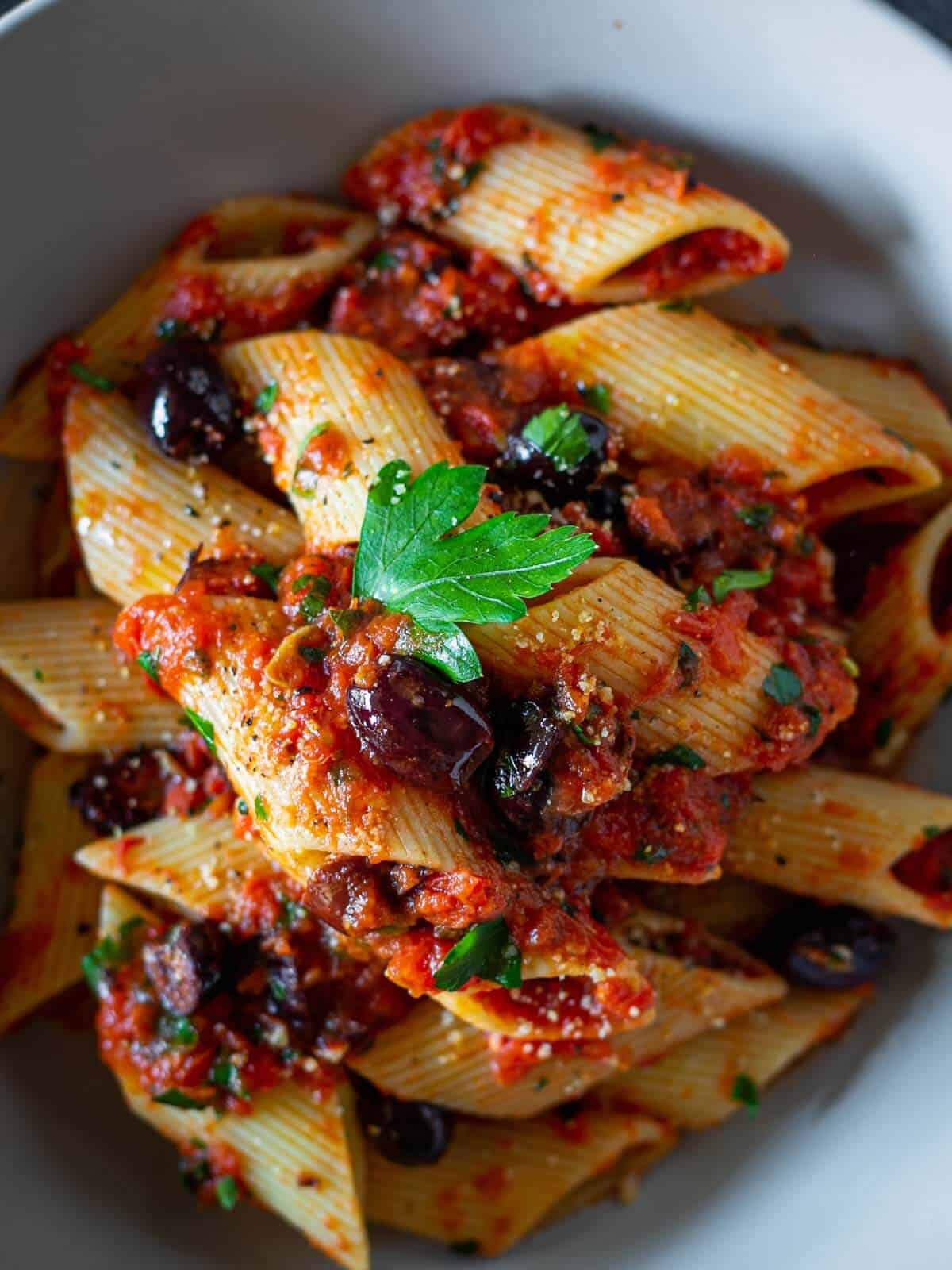
As with most Italian recipes, there are multiple versions of this sauce. Some include oregano, others, like the Lazio region version (Rome is part of the Lazio province), include anchovy fillets, and some even use anchovy paste.
We are making a traditional version and keeping it vegan, so we are not adding anchovies here. Add the chopped anchovies immediately after adding the pepper flakes if you add anchovies.
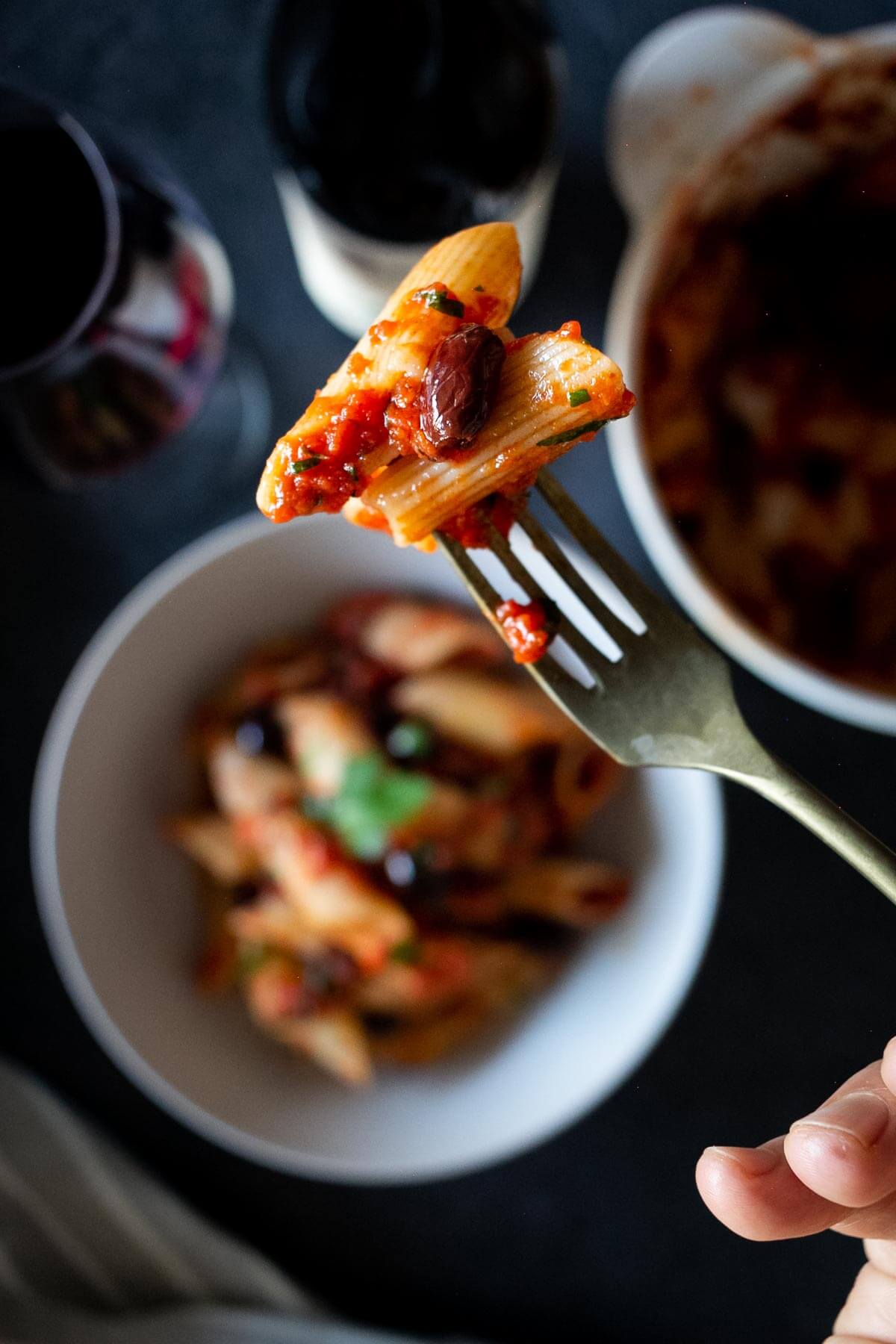
Not many times do we find initially vegan recipes here in Italy that need adaptation, so let's celebrate its beauty.
A puttanesca recipe cannot lack these ingredients: capers, olives, and of course, tomatoes.
The rest comes with regions and diet-specific adaptations!
Why puttanesca sauce?
If you are wondering what puttanesca means, here it goes. Puttanesca sauce was named after Italian women who were looking for easy ways to attract wealthy men. They came up with this idea of cooking puttanesca sauce on their windowsills while wearing lingerie and ostentatious makeup, making it seem like they were cooking just for them!
The wealthy clients would come by on their way home from work and find good-looking girls serving good food. The puttanesca sauce was put out on the window sills so that passers-by could smell its deliciousness.
Thus, puttanesca, also known as "prostitute's spaghetti" or "spaghetti a la puttana," started being served in Naples' finest restaurants.
🧾 Ingredients
This Easy Pasta Puttanesca sauce recipe has straightforward ingredients: pantry staples that will give you a robust flavor punch; thus, I recommend using good quality ones.
Totaling only 7 ingredients, this simple vegan puttanesca recipe will make you achieve a fantastic Italian restaurant pasta that will leave your guests drooling and asking for more.

- Pitted black olives
- Capers (salted capers if possible, finely chopped)
- Tomatoes (use tomato sauce, diced tomatoes, and canned tomatoes also work)
- Pepperoncino (crushed red pepper flakes)
- Garlic
- Fresh parsley
- Extra virgin olive oil
- Good quality pasta
You don't even need salt and pepper for this sauce, as the olives and capers bring all that in with the extra punch of red pepper flakes!
Choosing your ingredients wisely
Of course, you can use any pasta you like; this is a popular recipe at the end of the day. But as a rule of thumb here in Italy, when you are making an extremely simple recipe, like pasta puttanesca, you try to use exceptionally great ingredients.
I'll list which recipes are in order or priority for this great recipe.
The pasta
Pasta—I am sure you have heard of Penne Alla Puttanesca, which makes the name funnier. Well, here we use Pennoni, which is a larger version of penne. Their wider circumference allows the sauce to get into the pasta, making each bite a complete experience.
You can also make spaghetti alla puttanesca, but I particularly like how pennoni goes with this pasta sauce. It doesn't make much difference if you decide to make a fusilli puttanesca recipe or even puttanesca tagliatelle; the puttanesca sauce recipe works for all types of noodles.
Read on: how to make your own fresh vegan pasta dough »
Cappelli durum wheat
This ancient grain grows mainly in southern Italy. Ancient grains are varieties that have remained authentic and original throughout time; that is, they have not undergone any modification to increase their yield.
The best-known and most widespread is the Canadian Kamut, which has become an authentic registered brand.
Cappelli wheat is considered the father of durum wheat, and it has excellent nutritional qualities and flavor. When cooked, it exudes the fragrances of fresh farm milk and creamy mashed potatoes with a hint of roasted chestnuts.
We always add a healthy amount of salted water to cook pasta because the pasta will never shine enough if you don't salt it generously while boiling. You don't need oil when boiling pasta. It is a myth, and it is counterintuitive as it can prevent the sauce from sticking to the pasta; thus, you don't achieve the desired amalgamation of flavor.
Myth: oil is said to prevent the pot from boiling over and prevent the pasta from sticking together, but in reality, you just need to add the pasta to boiling water and stir it occasionally. The general consensus is adding oil to your pasta water does more harm than good.
The pasta sauce leading ingredients
Black olives
If you can get a hand of Gaeta olives. Gaeta is a beach town city located an hour away from Rome, which produces this variety of olives worldwide known for their particularly delicious flavor.
These olives have a mild tart and salty flavor, have a violet color when brine-cured, and are very soft and fleshy, making them ideal for this sauce. You want the black olives to become smooth and part of the sauce.
Alternatively, you can also use kalamata olives with similar color, flavor, and texture. They are more significant than Gaeta olives.
Capers
Originally, this recipe was made with salted capers, but you can also use capers in brine. If you use briny capers, make sure you strain them under running water for them to lose some of their saltiness. We will use them roughly chopped.
Tomatoes
Use good quality ripe cubed tomatoes (without their skin) or tomato puree Italian passata). You can also use canned tomatoes.
Red pepper flakes
Use either fresh fragrant red chilies or dried pepperoncino flakes, as we did. I took away some of the white seeds that generally come with it to control the dish's heat.
Tip: If you don't love spicy food, reduce the number of red chili flakes to half. Puttanesca pasta is meant to be spicy, and so is this recipe as written.
Seasonings
Olive oil
This recipe calls for a tiny quantity of oil, so you don't need to go crazy about this one! Nothing beats a good hint of good quality olive oil. I like using either Gaeta extra virgin olive oil to match the Gaeta olive flavor profile or the widely known Tuscan Olive oil variety, Frantoio.
Parsley
Use fresh parsley; don't use dried one. The point of adding this final touch to the dish is to give it some freshness and counteract the heat from the pepperoncino. You won't achieve this purpose using dried parsley.
Garlic
Cooking garlic in this recipe is simple as it is only used to infuse the olive oil and take it out. Resist the temptation to mince it and add more garlic than the recipe calls for because it will overshadow the rest of the carefully selected flavors.
No salt and ground pepper are needed for your sauce! We already have enough salty ingredients in the recipe.
🔪 Instructions
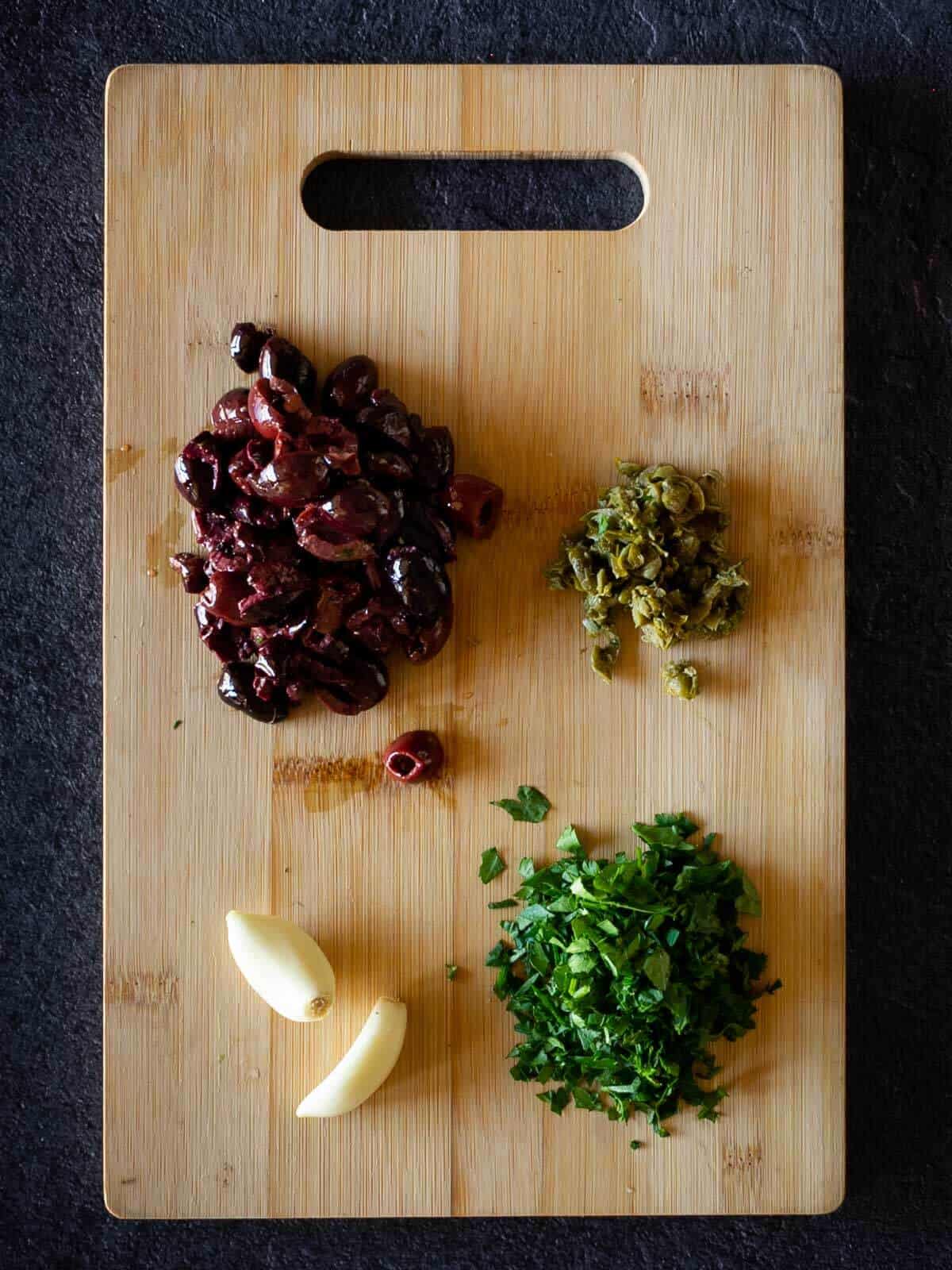
Step 1: Roughly chop the capers (remember to drain them under running water first). Mash the olives with the back of a knife—no need to chop them. Finely chop the fresh parsley.
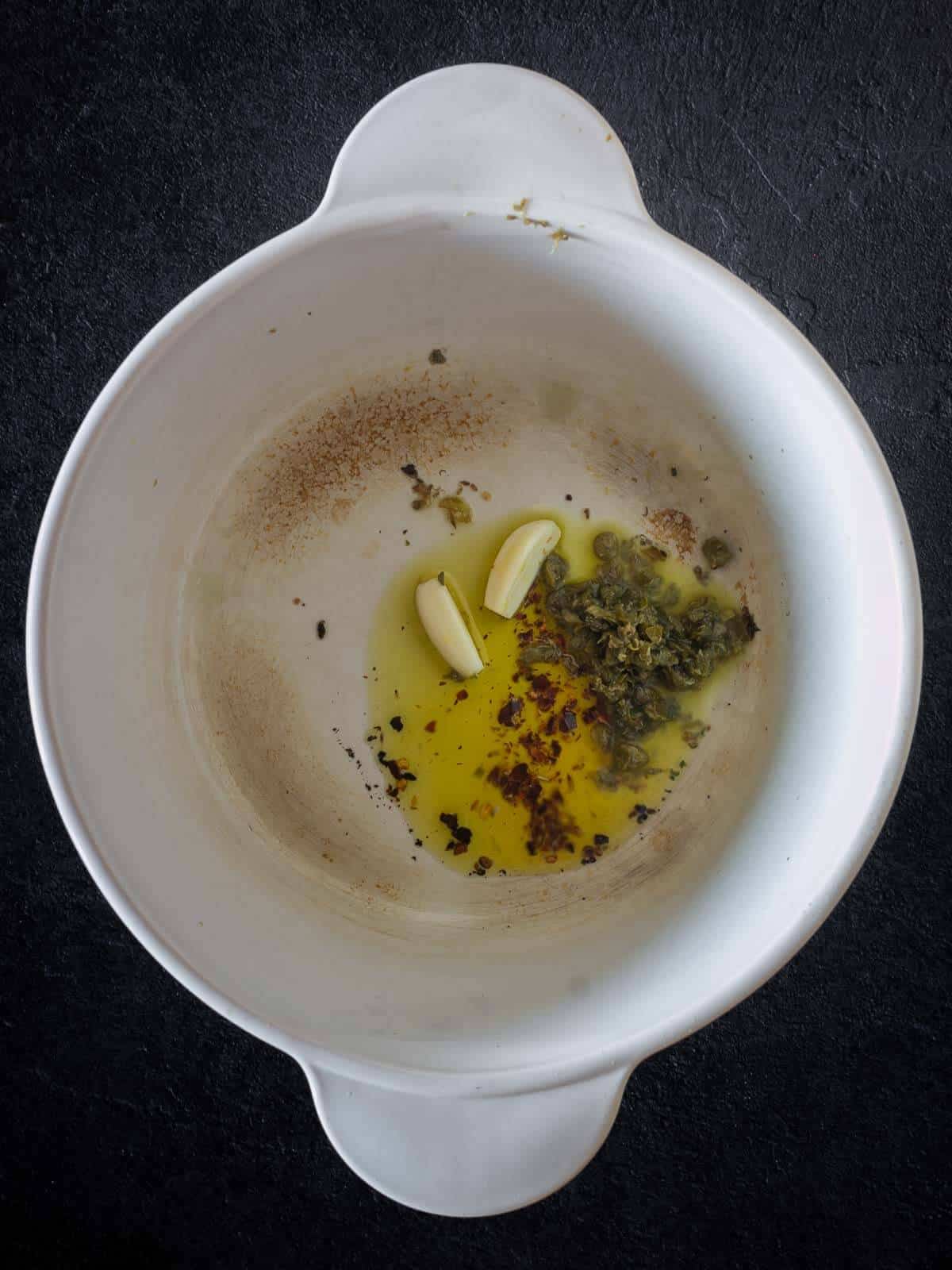
Step 2: To cook the sauce, heat oil on a medium skillet (or large skillet, making a larger quantity) or saucepan. Then add the red pepper flakes, and add garlic cloves (whole; don't use a garlic press, cook garlic, and take off the sauce later) to infuse the olive oil with flavor until garlic and red flakes are lightly golden. Use a wooden spoon to stir. Then add the tomato sauce and let cook. Don't let the chili flakes burn.
Note: Be aware that the chili flakes can heat the air and air the kitchen.
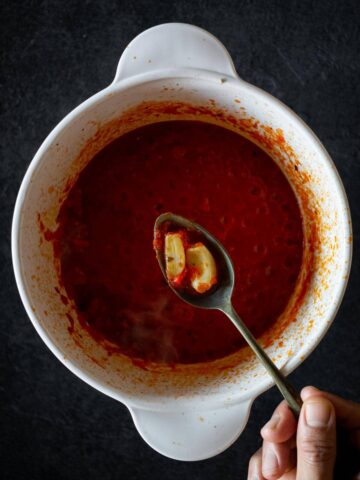
Step 3: Remove garlic from sauce.
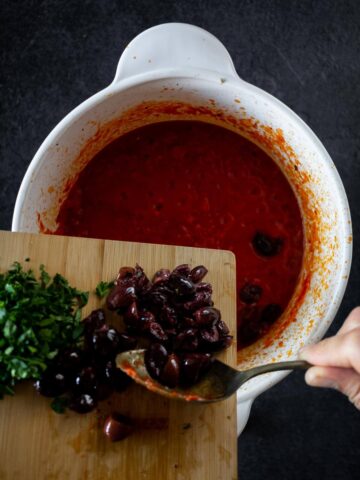
Step 4: After a minute, add the chopped capers, followed by the tomato sauce, stirring occasionally while cooking pasta. Let it cook for ten minutes on medium heat. Then, remove the pasta sauce from the heat and add the olives and the chopped fresh parsley.
Tip: while the pasta cooks, with a wooden spoon, make sure you stir it two or three times to prevent it from sticking to the bottom of the pot. Especially if making spaghetti puttanesca, as long pasta tends to stick together.

Step 5: Cook the pasta until it is al dente, and level some starchy pasta water.
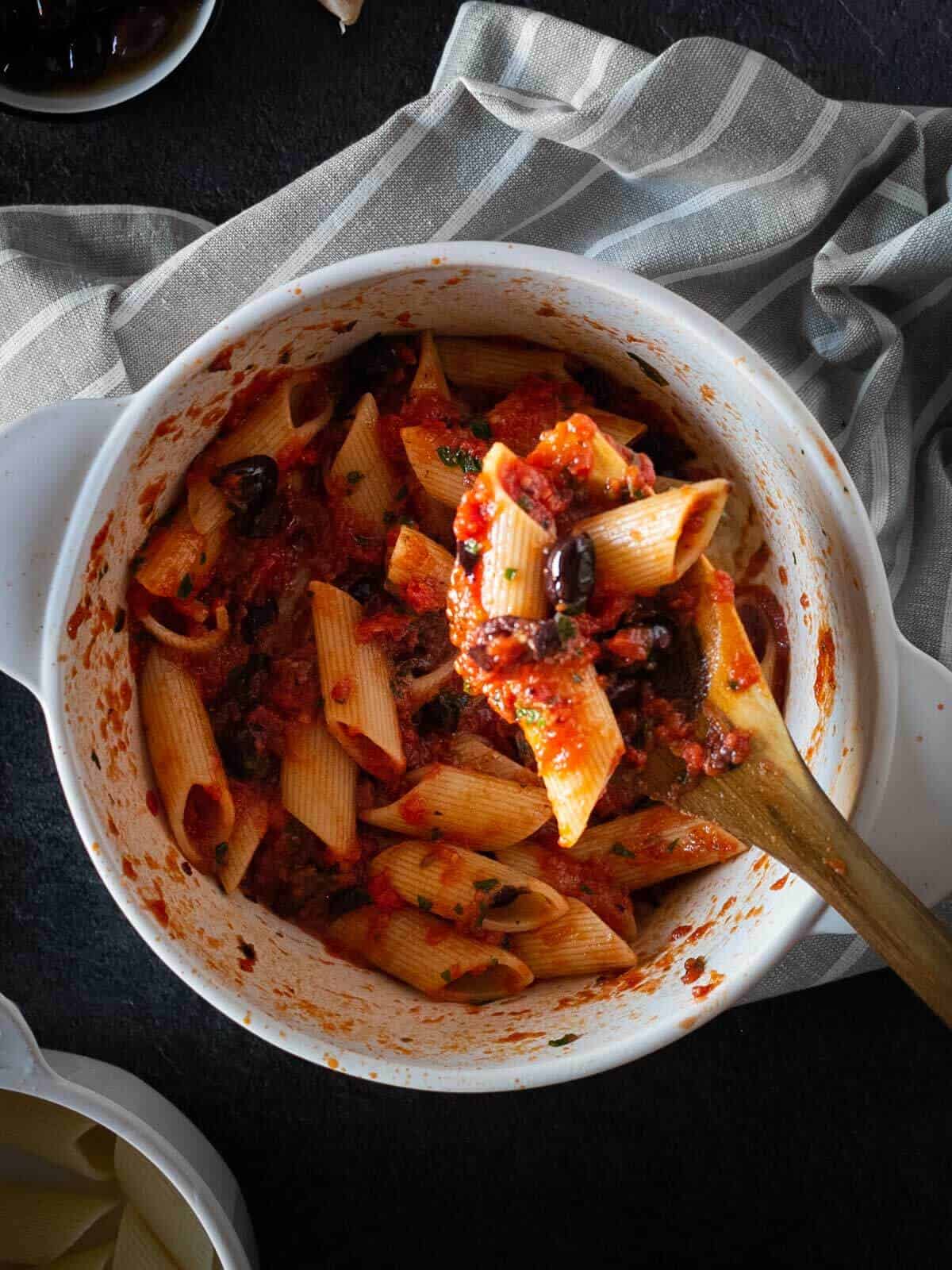
Step 6: Add cooked pasta to the pasta sauce. Stir well and serve immediately. You don't even need salt and pepper, as the ingredients already have all the flavor you need.
Tip: if you want the pasta to be saucier and creamier, add just a little pasta water (cooking water) to the skillet and stir well.
If you like to add parmesan to your pasta, use our 5-minutes Vegan Parmesan recipe.

If you will serve some more and need to reheat it, use some reserved cooking water to make your leftover creamier.
📖 Variations
Pasta puttanesca is often made with chopped anchovy fillets in certain regions of Italy, making the sauce taste fishy and extra salty. We skipped those to have a fully vegan and healthy recipe.
- Tomato - if you choose to use fresh crushed tomatoes, go for plum tomatoes.
- Pasta - another great option to have pasta puttanesca is making spaghetti alla puttanesca. Like this ancient grain Pugliese variety, the capers and olives also find their way along with a good quality Italian spaghetti. Spaghetti puttanesca is also widely found in Italian restaurant menus, head to head with penne alla puttanesca.
- Herbs - some people like using fresh basil on their pasta puttanesca. As much as I am a fan of basil, I only use parsley as the original recipes call for it. Fresh basil adds notes to the dish that aren't supposed to go there. I keep basil for my Eggplant pasta sauce, also called pasta alla norma.
- Heat - you use crushed red pepper in your pasta puttanesca if you don't have pepperoncino or red pepper flakes. This great recipe relies entirely on capers, olives, garlic, and tomatoes, so focus on those to achieve the best results.
- Gluten-free - puttanesca sauce is naturally gluten-free. Make sure to use gluten-free pasta to make your spaghetti alla puttanesca celiac-friendly.
🍷 Wine pairing
We like pairing this delicious pasta puttanesca with an Italian Piedmontese Dolcetto red wine. Dolcetto (translated as sweet little one), whose name can be misleading, isn't a sweet wine; it is relatively dry and easy to drink.
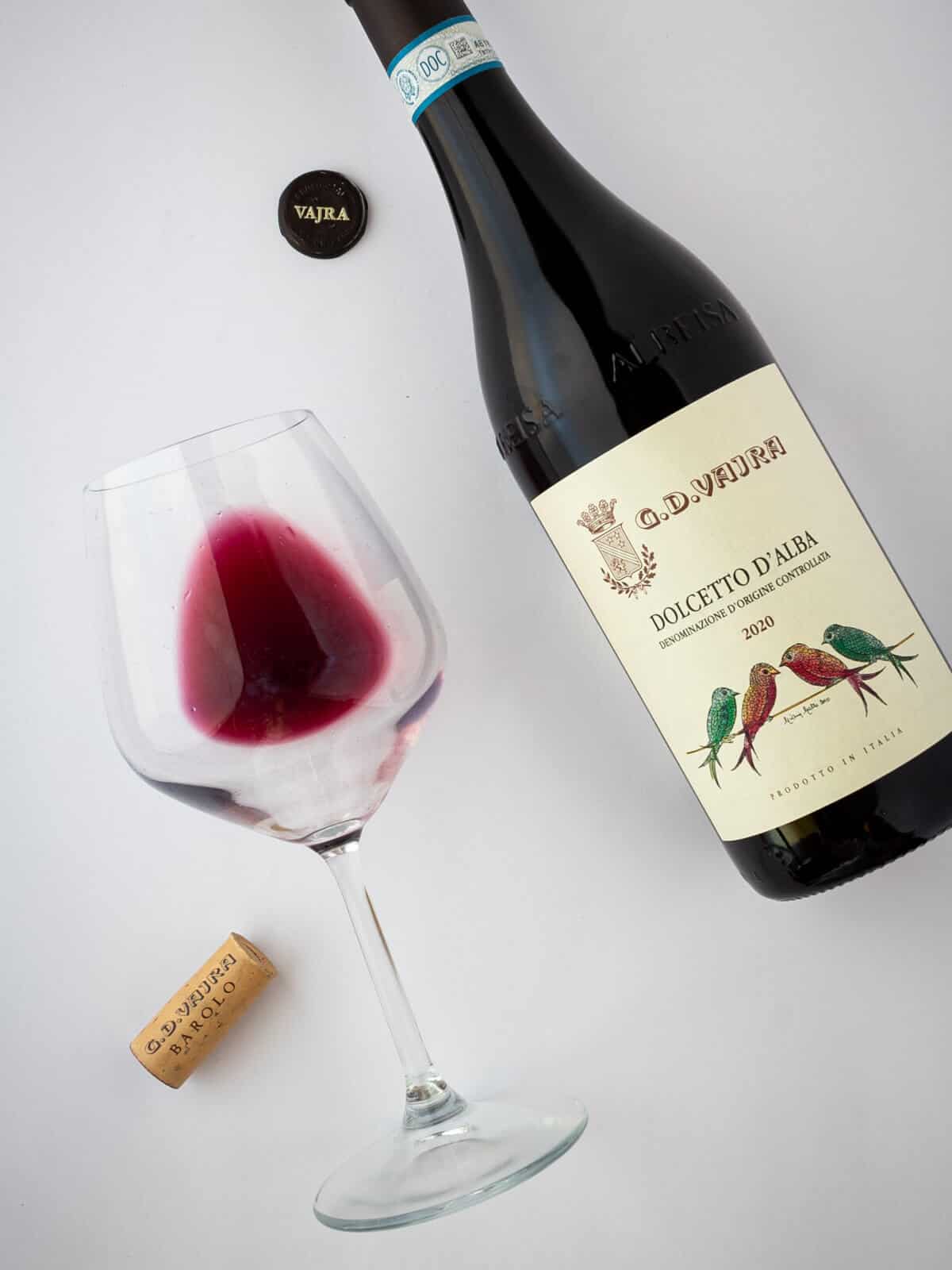
It is a tannic, low-acidity wine that combines well with Italian food, such as pasta and pizza, especially eggplant, garlic, and tomato sauce. Dolcetto wines also pair fantastically with spicy foods such as curries.
Vajra's Dolcetto D'Alba also pairs wonderfully with our Eggplant's 3-Ingredient pasta sauce.
An Eggplant Caponata (also available at La Dolce Vita Italy) is a great way to pair this wine and our Indian Eggplant Curry.
🇮🇹 More easy Italian recipes
- 3-Ingredient Eggplant pasta sauce
- 4-Ingredient Eggplant Stew
- 5-minute Vegan Basil Pesto Sauce
- Cacio e peppe spaghetti
- No-fry eggplant parmesan
- Creamy Eggplant Pasta with Tomato Ricotta Sauce
⭐ If you try this recipe, let us know! 💬 Leave a comment, rate it, and don't forget to tag us @ourplantbasedworld on Instagram. Cheers!
📋 Recipe

Vegan Puttanesca Pasta Sauce
Equipment
Ingredients
- 15 oz tomato sauce passata, or pealed cubed tomatoes
- 2 teaspoons capers
- 1 parsley fresh, finely chopped
- ⅓ cup black olives Gaeta olives are the best, alternatively use Kalamata olives
- 2 cloves garlic whole
- ½ teaspoon chili peppers dried, pepperoncino, reduce to half if you don’t love spicy food
- 1 tablespoon olive oil use only 1 tablespoon if your black olives come with oil
Pasta
- 7 oz pennoni pasta or penne, spaghetti, fusilli. Gluten-free
- 1 tablespoon sea salt
Optional:
Directions
- Boil Water: Set a pot with water to boil and stir in the sea salt.
- Prep Ingredients: If using salted capers, rinse and then chop roughly. Mash or chop the olives. Finely slice the parsley.
- Infuse Oil: On low heat in a skillet, combine oil, chili flakes, and garlic cloves to infuse flavors. Keep your kitchen aired!
- Add Sauce: After a minute, blend in the capers and then pour in the tomato sauce. Allow simmering while attending to the pasta, stirring occasionally.
- Cook Pasta: Follow package instructions to cook your chosen pasta until al dente.
- Season Sauce: Remove skillet from heat and integrate the olives and parsley into the sauce. Toss out the garlic cloves.
- Combine & Serve: Drain the cooked pasta, reserving some cooking water. Combine pasta and sauce, adjusting creaminess using the reserved water if needed.
Video
Notes
Nutrition Facts
Nutritional Disclaimer
The information shown is an estimate provided by an online nutrition calculator. It should not be considered a substitute for a professional nutritionist's advice. See our full Nutritional Disclosure here.
Affiliate Disclaimer
Please note that some of the links here are affiliate links, and I will earn a commission if you purchase through those links. I recommend all of the products listed because they are companies I have found helpful and trustworthy.
As the lead content writer and recipe developer at Our Plant-Based World, he combines his passion for health and sustainability with a Plant-Based Nutrition Certification to create accessible, delicious vegan recipes. His expertise in plant-based cooking supports the blog's mission of fostering a healthier, environmentally conscious lifestyle through simple and seasonal dishes. His commitment to making vegan cooking enjoyable and inclusive for everyone shines in each recipe and article.


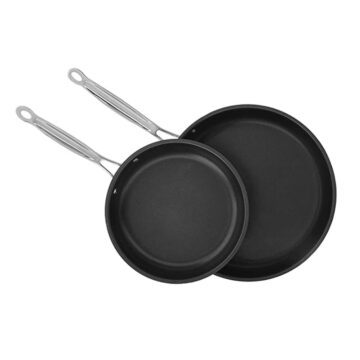


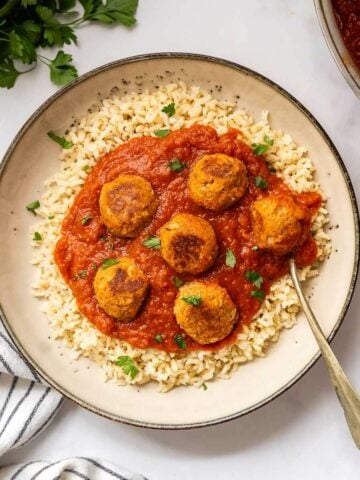
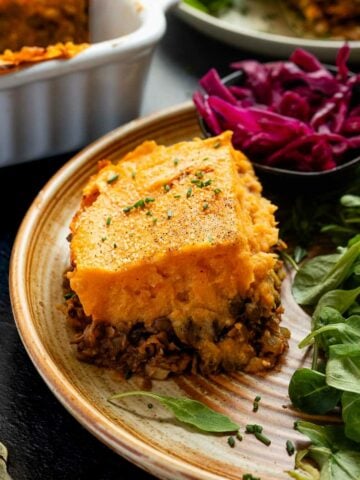

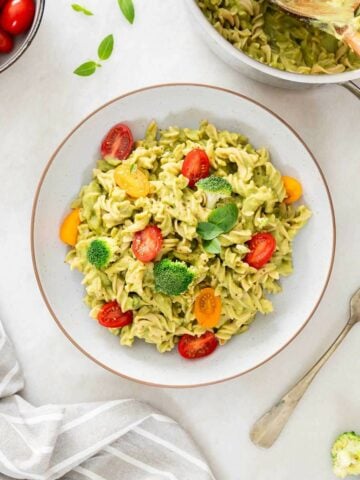
Toni
Everyone at my house loved this! Thanks for the tips and the recipe!
Leslie
Thank you so much for this recipe! I grew up with Italian family recipes once a week as a child....but we never had this delicious sauce. The capers and olives are so tasty, and I can't wait to try it with anchovies next time.